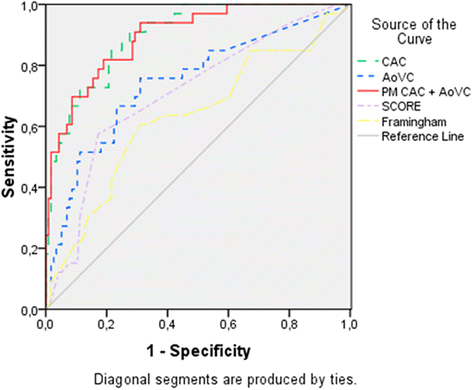Additional value of associating aortic valve calcification to coronary calcium as a gatekeeper for coronary tomography angiography
- PMID: 26130116
- PMCID: PMC4486129
- DOI: 10.1186/s12872-015-0058-5
Additional value of associating aortic valve calcification to coronary calcium as a gatekeeper for coronary tomography angiography
Abstract
Background: Aortic valve calcification shares risk factors with coronary artery disease. Coronary calcium has been used has a gatekeeper to performing coronary tomography angiography. The aim of this study was to evaluate aortic valve calcification as a predictor of obstructive coronary artery disease by computed tomography, and its possible usefulness, alongside with coronary calcium, to improve the decision of whether or not to proceed with computed tomography angiography.
Methods: Transversal case-control study including 154 consecutive patients (62 ± 12 years, 57.6 % female, without known coronary or valve disease) undergoing calcium scoring and angiography through computed tomography (Phillips Brilliance, 16-slice). Predictors of aortic valve calcification and obstructive coronary artery disease were identified. Usefulness of aortic valve calcification when added to calcium score for prediction of obstructive coronary artery disease was assessed by binary logistic regression and net reclassification index.
Results: Aortic valve calcification was associated with higher coronary calcium, extent and prevalence of obstructive coronary disease, which was identified in 22.1 % of patients and was discriminated by aortic valve calcium with an area under curve 0.749 (p < 0.001, Youden index: 61). A higher discriminative power was achieved with a model based on coronary and aortic valve calcification (AUC 0.900, p < 0.001). Compared with calcium score >400 as a gatekeeper to angiography, the association of aortic calcium >61 allowed a net reclassification index of +7.7 % of patients.
Conclusions: Aortic valve calcification is associated with the prevalence and extent of obstructive coronary artery disease by computed tomography angiography and is an easy, fast and useful method to improve the selection of patients for angiography.
Figures

Similar articles
-
Aortic root, not valve, calcification correlates with coronary artery calcification in patients with severe aortic stenosis: A two-center study.Atherosclerosis. 2015 Dec;243(2):631-7. doi: 10.1016/j.atherosclerosis.2015.10.014. Epub 2015 Oct 22. Atherosclerosis. 2015. PMID: 26551591
-
Correlation and predictive value of aortic root calcification markers with coronary artery calcification and obstructive coronary artery disease.Radiol Med. 2017 Feb;122(2):113-120. doi: 10.1007/s11547-016-0707-5. Epub 2016 Nov 14. Radiol Med. 2017. PMID: 27844188
-
The impact of gender on cardiovascular system calcification in very elderly patients with severe aortic stenosis.Int J Cardiovasc Imaging. 2016 Jan;32(1):173-9. doi: 10.1007/s10554-015-0752-5. Epub 2015 Aug 29. Int J Cardiovasc Imaging. 2016. PMID: 26319217
-
Cardiovascular morbidity and mortality in patients with aortic valve calcification: A systematic review and meta-analysis.J Cardiovasc Comput Tomogr. 2019 Jul-Aug;13(4):190-195. doi: 10.1016/j.jcct.2019.06.006. Epub 2019 Jun 11. J Cardiovasc Comput Tomogr. 2019. PMID: 31239172
-
Leveraging the coronary calcium scan beyond the coronary calcium score.Eur Radiol. 2018 Jul;28(7):3082-3087. doi: 10.1007/s00330-017-5264-3. Epub 2018 Jan 30. Eur Radiol. 2018. PMID: 29383526 Free PMC article. Review.
References
-
- Perrone-Filardi P, Achenbach S, Möhlenkamp S, Reiner Z, Sambuceti G, Schuijf JD, Van der Wall E, Kaufmann PA, Knuuti J, Schroeder S, Zellweger MJ. Cardiac computed tomography and myocardial perfusion scintigraphy for risk stratification in asymptomatic individuals without known cardiovascular disease: a position statement of the Working Group on Nuclear Cardiology and Cardiac CT of the European Society of Cardiology. Eur Heart J. 2011;32:1986–93. doi: 10.1093/eurheartj/ehq235. - DOI - PubMed
-
- Greenland P, Bonow R, Brundage BH, Budoff MJ, Eisenberg MJ, Grundy SM, Lauer MS, Post WS, Raggi P, Redberg RF, Rodgers GP, Shaw LJ, Taylor AJ, Weintraub WS. ACCF/AHA 2007 Clinical Expert Consensus Document on Coronary Artery Calcium Scoring By Computed Tomography in Global Cardiovascular Risk Assessment and in Evaluation of Patients With Chest Pain. J Am Coll Cardiol. 2007;49(3):378–402. doi: 10.1016/j.jacc.2006.10.001. - DOI - PubMed
-
- Leber AW, Knez A, Mucherjee R, White C, Huber A, Becker A, Becker CR, Reiser M, Haberl R, Steinbeck G. Usefulness of calcium scoring using electron beam computed tomography and noninvasive coronary angiography in patients with suspected coronary artery disease. Am J Cardiol. 2001;88:219–23. doi: 10.1016/S0002-9149(01)01629-0. - DOI - PubMed
MeSH terms
Supplementary concepts
LinkOut - more resources
Full Text Sources
Other Literature Sources
Medical

